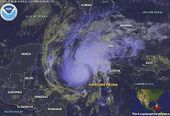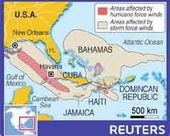Fulfilling forecasters' predictions for a high number of strong hurricanes, one storm after another in August and September hit the Bahamas, Cuba, Dominican Republic, Haiti, Jamaica, the British Turks and Caicos Islands, and the southeastern United States. Fay, Gustav, Hanna and Ike followed within weeks of each other.
Haiti - the poorest country in the Americas - is ill prepared to prepare for storms or cope with their consequences, and suffered the highest number of deaths when it was hit in turn by all four. It's hard to pin down an exact toll from floods and mudslides caused by a series of storms in August and September 2008 - since many corpses were washed out to sea - but police and local authorities say it was around 700.
Aid workers say at least 800,000 Haitians have been affected, thousands of homes destroyed or damaged, and crops and livestock wiped out. The port city of Gonaives was left filled with sludge, without food and clean water, and cut off from supplies. With bridges and roads washed out, helicopter and boat was the only way in.
Cuba - proud of its hurricane alert system and efficient evacuations - evacuated more than 2.5 million people (about 22 percent of the country's 11.4 million population) and escaped with a death toll you could count on the fingers of one hand. But 320,000 homes were damaged by the storms, adding to the housing woes in a country which already had a shortage of about 500,000 homes.

The Atlantic hurricane season runs from June to November in the Caribbean, posing a threat to coastal communities when tropical storms and hurricanes generate storm surges and trigger landslides and flash floods.
Forecasters have predicted an unusually busy hurricane season for 2008. An average season has 10 tropical storms, of which six strengthen into hurricanes.
A "hurricane" is a revolving tropical storm accompanied by torrential rain and wind speeds exceeding 119 kilometres per hour (74 miles per hour). In the Americas and Caribbean, these storms are called "hurricanes". In the western Pacific, East Asia and Australia they are "typhoons". And in the Indian Ocean they are "cyclones".
Flooding in wider region
Elsewhere in Latin America, torrential rains between December and May can swamp agricultural land, destroy livelihoods, damage homes and services and force mass evacuations.
In early 2008, devastating floods hit Bolivia, Ecuador and Peru as a weather abnormality known as La Nina brought some of the heaviest rains in a quarter-century, swelling rivers and bursting banks. Ecuador and Peru both declared states of emergency.
Meaning "little girl" in Spanish, La Nina is an unusual cooling of Pacific Ocean surface temperatures that can trigger more hurricanes and worse rains in many places.




Reader Comments
to our Newsletter